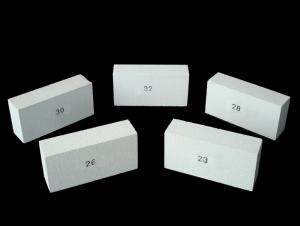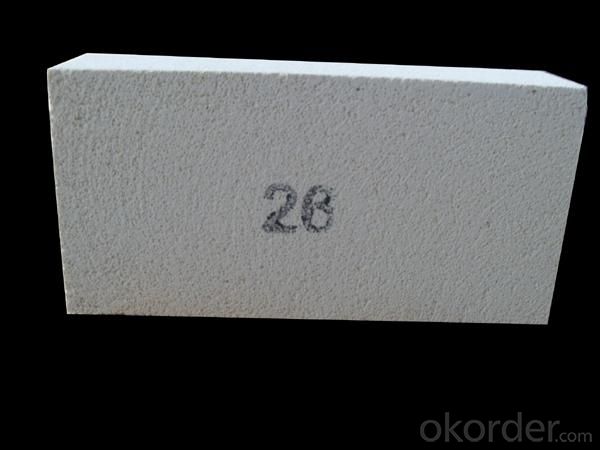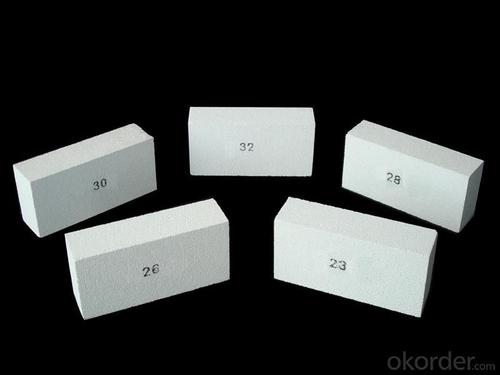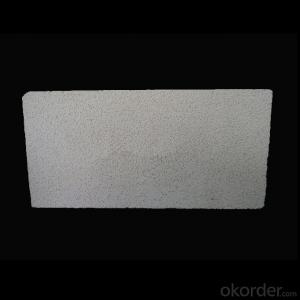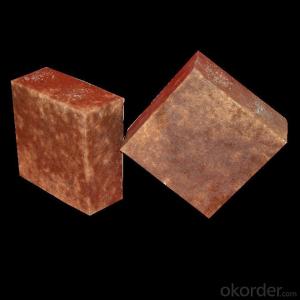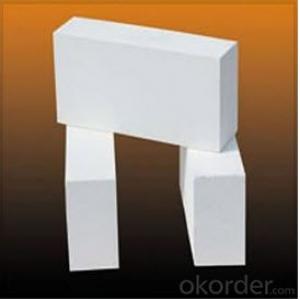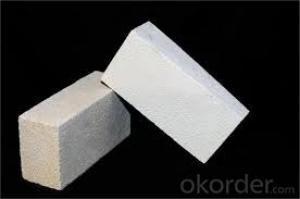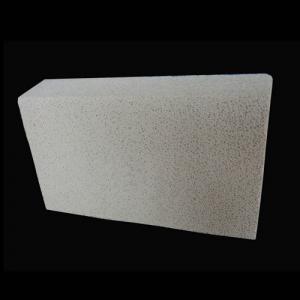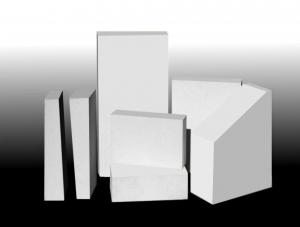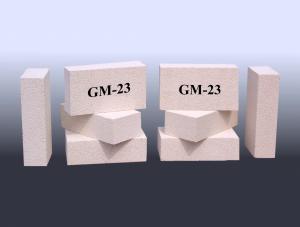Insulating Fire Brick - GJM28
- Loading Port:
- China Main Port
- Payment Terms:
- TT or L/C
- Min Order Qty:
- 1000 pcs pc
- Supply Capability:
- 1000 Tons Per Month pc/month
OKorder Service Pledge
OKorder Financial Service
You Might Also Like
General Information of Insulating Fire Brick GJM28
Insulating fire brick GJM28 are produced by high purity alumina and low iron raw materials. A viariety of shapes are available.
To make our firebricks more energy and cost effective, we have different manufacturing methods for our insulating fire bricks casting and extruding method.
For insulating fire bricks GJM28,we choose the extruding method. Extruding insulating fire bricks have better strength and offering great performance in load bearing applications and in conditions where abrasion from mechanical abuse or flow of hot gases.
Characteristics of Insulating Fire Brick GJM28
The organic fillers, which are mixed in the materials and then burned out during sintering, give our insulating fire bricks a uniform controllable pore structure. The insulating fire bricks exhibit the following characteristics:
Light weight and low thermal conductivity allows thinner furnace walls
Maintain stable structural strength throughout ambient to maximum service termperature
Low heat storage results in rapid cooling and heating operation
Low iron and impurities to enhance reducing atmosphere
High thermal shock resistance in preventing spalling
Typical Application of Insulating Fire Brick GJM28
Ceramic shuttle kilns
Metal heat treatment furnaces
Steel billet reheating furnaces
Oil refrinery heaters
Laboratory furnaces
Backup insulation for all furnaces
Technical Data of Insulating Fire Brick GJM28
|
| GJM28 |
Physical Properties: |
|
|
Classifiction Temperature | ℃ | 1500.0 |
Density | Kg/m3 | 900.0 |
Cold Crushing Strength | Mpa | 2.5 |
Reheating Linear Change(24hrs) |
|
|
1510℃ | % | 0.6 |
Hot Load Strength Deform(90 minutes) |
|
|
1320℃ at 0.069 Mpa(10psi) | % | 0.3 |
Thermal Conductivity |
|
|
400℃ | W/m.k | 0.3 |
600℃ | W/m.k | 0.3 |
800℃ | W/m.k | 0.4 |
1000℃ | W/m.k | 0.4 |
1200℃ | W/m.k | 0.4 |
Specific Heat | KJ/Kg.K | 1.1 |
Chemical Analysis: |
|
|
Al2O3 | % | 60.0 |
SiO2 | % | 38.2 |
Fe2O3 | % | 0.6 |
TiO2 | % | 0.1 |
CaO | % | 0.1 |
MgO | % | 0.1 |
Na2O+K2O | % | 0.8 |
We has success in insulating fire bricks due to their cost-effectiveness, excellent insulation properties. CNBM also has experience in insulating fire bricks application and would like to assist you in product selection, system design, and installation techniques.


- Q: Can insulating fire bricks be used in chimney construction?
- Indeed, insulating fire bricks have the capability to be utilized in the construction of chimneys. These bricks are specifically designed to possess a low thermal conductivity, which ultimately leads to their effectiveness in minimizing heat transfer. As a result, they prove themselves suitable for chimney construction as they aid in maintaining cooler chimney walls and preventing excessive heat from being transmitted to the surrounding structures. Moreover, apart from their lightweight nature, insulating fire bricks possess commendable insulation properties, thereby making their handling and installation in chimney construction a much simpler task. However, it is imperative to acknowledge that in order to comply with safety regulations and ensure proper chimney construction, it is crucial to utilize insulating fire bricks in conjunction with other fire-resistant materials.
- Q: Can insulating fire bricks be used in the construction of hearth furnaces?
- Indeed, hearth furnaces can absolutely incorporate insulating fire bricks. These remarkable bricks are specifically engineered to possess a low thermal conductivity, rendering them exceptionally suitable for scenarios necessitating heat insulation. By utilizing insulating fire bricks in the construction of hearth furnaces, where elevated temperatures prevail, the retention of heat within the furnace is facilitated, thereby enhancing energy efficiency. Furthermore, their implementation minimizes heat transfer, thereby offering thermal protection to nearby structures. Moreover, owing to their lightweight nature and ease of handling, insulating fire bricks are remarkably convenient for construction purposes. All in all, incorporating insulating fire bricks into the construction of hearth furnaces elevates their performance and contributes to a more efficient and effective heating process.
- Q: Do insulating fire bricks expand and contract with temperature changes?
- Yes, insulating fire bricks do expand and contract with temperature changes.
- Q: What are the key properties of insulating fire bricks?
- Insulating fire bricks, also known as IFBs, possess several key properties that make them highly effective in various industrial applications. Firstly, insulating fire bricks have a high level of thermal insulation. This means that they are capable of withstanding extremely high temperatures while minimizing heat transfer. This thermal insulation property allows for the retention of heat within the desired area, preventing heat loss and improving overall energy efficiency. Secondly, insulating fire bricks have excellent refractory properties. Refractoriness refers to the ability of a material to withstand high temperatures without deforming or deteriorating. IFBs are specifically designed to have a high refractory rating, enabling them to withstand temperatures up to 3000°F (1650°C) without succumbing to thermal shock or breaking down. Another key property of insulating fire bricks is their low thermal conductivity. This property ensures that heat is not easily conducted through the bricks, leading to reduced heat loss and increased energy conservation. The low thermal conductivity of IFBs also allows for rapid heating and cooling cycles, making them ideal for applications that require quick temperature changes. Furthermore, insulating fire bricks are lightweight and have a high strength-to-weight ratio. This makes them easy to handle, transport, and install, reducing labor and logistical costs. Despite their lightweight nature, IFBs are still capable of maintaining structural integrity and providing reliable insulation. Lastly, insulating fire bricks are highly resistant to chemical attack and corrosion, ensuring their durability and longevity in harsh environments. They are commonly used in applications involving acids, alkalis, and other corrosive substances, providing reliable insulation and protection. In summary, the key properties of insulating fire bricks include high thermal insulation, excellent refractory properties, low thermal conductivity, lightweight yet strong structure, and resistance to chemical attack. These properties make IFBs highly desirable for a wide range of industrial applications, including furnaces, kilns, incinerators, and other high-temperature environments.
- Q: Can insulating fire bricks be used in the construction of heat recovery systems?
- Insulating fire bricks are a viable option for heat recovery system construction. These bricks are specifically designed to endure high temperatures and deliver exceptional thermal insulation, making them an excellent choice for heat recovery systems. They are crafted from lightweight materials, such as ceramic fibers or refractory materials, which possess low thermal conductivity. This feature enables them to effectively capture and retain heat, preventing its escape from the system and maximizing energy efficiency. Moreover, insulating fire bricks exhibit resistance to thermal shock, meaning they can withstand sudden temperature fluctuations without undergoing cracks or breakage. Consequently, they are well-suited for the fluctuating heat conditions commonly encountered in heat recovery systems. Ultimately, incorporating insulating fire bricks into the construction of heat recovery systems can enhance their performance and efficiency by reducing heat loss and optimizing energy recovery.
- Q: Are insulating fire bricks suitable for use in coke ovens?
- Insulating fire bricks are not suitable for use in coke ovens. Coke ovens require bricks that can withstand extremely high temperatures and harsh chemical environments. Insulating fire bricks are designed to provide thermal insulation and are not able to withstand the heat and chemical exposure that occurs in coke ovens. Therefore, it is crucial to use refractory bricks specifically designed for coke ovens, which have high resistance to temperature, chemical attacks, and thermal shock. These refractory bricks are typically made from materials such as silica, alumina, and carbon, which can withstand the harsh conditions inside the coke ovens.
- Q: What is the typical weight of an insulating fire brick?
- The weight of an insulating fire brick can differ based on its specific type and manufacturer. On average, it falls within the range of 2.5 to 3.5 pounds (1.1 to 1.6 kilograms). It's worth noting that this weight estimation applies to a standard-sized brick measuring 9 x 4.5 x 2.5 inches (22.9 x 11.4 x 6.4 centimeters). Slight variations in weight may occur due to varying densities and compositions of these bricks. Therefore, it is advisable to consult the manufacturer's specifications for precise information.
- Q: Are insulating fire bricks suitable for use in residential fireplaces?
- Yes, insulating fire bricks are suitable for use in residential fireplaces. They are designed to withstand high temperatures and provide insulation, making them an ideal choice for ensuring the safety and efficiency of a residential fireplace.
- Q: Can insulating fire bricks be used in the construction of combustion chambers for rocket engines?
- Insulating fire bricks are capable of being utilized in the construction of rocket engine combustion chambers. They are specifically engineered to endure elevated temperatures and provide exceptional thermal insulation. This makes them an ideal option for situations involving extreme heat, such as rocket engine combustion chambers. The main purpose of insulating fire bricks in a rocket engine's combustion chamber is to shield the surrounding structure from the intense heat generated during combustion. By offering insulation, these bricks aid in minimizing the transfer of heat to the outer walls of the combustion chamber, thus averting damage and ensuring the chamber's structural integrity. Moreover, insulating fire bricks possess a lightweight composition and exhibit low thermal conductivity, enabling them to effectively retain heat within the combustion chamber. This characteristic is vital for maintaining optimal combustion efficiency and enhancing rocket performance. In addition to their thermal properties, insulating fire bricks are recognized for their durability and resistance to thermal shock. This attribute is particularly valuable in rocket engine applications where rapid temperature fluctuations can occur, such as during ignition or shutdown sequences. The ability of insulating fire bricks to endure such thermal stresses is imperative for the dependable operation and extended lifespan of the combustion chamber. Overall, insulating fire bricks are a suitable choice for constructing combustion chambers in rocket engines due to their ability to withstand high temperatures, provide thermal insulation, possess a lightweight nature, and exhibit durability.
- Q: What is the thermal expansion of insulating fire bricks?
- The thermal expansion of insulating fire bricks refers to the change in dimensions or volume of these bricks as a result of temperature changes. Insulating fire bricks are designed to have low thermal conductivity and high resistance to heat, making them suitable for applications where insulation and heat containment are crucial. The thermal expansion of insulating fire bricks is relatively low compared to other types of fire bricks. This is due to the composition and manufacturing process of these bricks, which typically involve lightweight materials such as clay, alumina, and silica mixed with organic additives. The low thermal expansion of insulating fire bricks allows them to retain their shape and structural integrity even when exposed to high temperatures. This property is particularly important in applications where thermal cycling occurs, such as in furnaces, kilns, and thermal insulation systems. To determine the exact thermal expansion coefficient of insulating fire bricks, it is necessary to consider the specific composition and manufacturing process of the particular brand or type of brick. However, in general, insulating fire bricks have a lower thermal expansion coefficient compared to other conventional fire bricks, which ensures their stability and longevity in high-temperature environments.
1. Manufacturer Overview
| Location | Jiangsu, China |
| Year Established | 2008 |
| Annual Output Value | Above US$ 35 Million |
| Main Markets | Germany; Italy; Turkey; France; England; Japan; Thailand; Vietnam; Idonesia; USA |
| Company Certifications | ISO 9001:2008 |
2. Manufacturer Certificates
| a) Certification Name | |
| Range | |
| Reference | |
| Validity Period |
3. Manufacturer Capability
| a) Trade Capacity | |
| Nearest Port | Shanghai; Qingdao |
| Export Percentage | 10% |
| No.of Employees in Trade Department | 3 People |
| Language Spoken: | English; Chinese; |
| b) Factory Information | |
| Factory Size: | Twenty five thousand tons per year |
| No. of Production Lines | Above 5 |
| Contract Manufacturing | OEM Service Offered; Design Service Offered |
| Product Price Range | High; Average |
Send your message to us
Insulating Fire Brick - GJM28
- Loading Port:
- China Main Port
- Payment Terms:
- TT or L/C
- Min Order Qty:
- 1000 pcs pc
- Supply Capability:
- 1000 Tons Per Month pc/month
OKorder Service Pledge
OKorder Financial Service
Similar products
Hot products
Hot Searches
Related keywords
